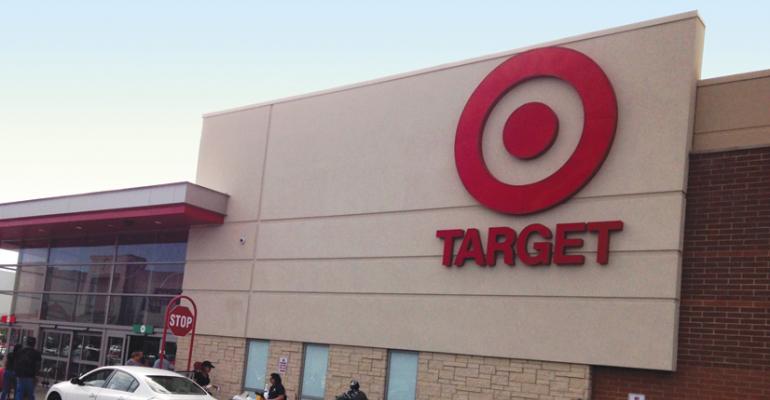After rolling out P-fresh remodels that have greatly expanded its offering of food products in most of its stores, and then expanding into Canada, Target’s next big move may be in its more holistic approach to health and wellness.
The Minneapolis-based discounter has introduced a new private label featuring natural and organic product, a new crowd-sourced campaign seeking innovations, and several initiatives in both food and nonfood categories that position the company as an authority on health and well-being.
“They are focusing overall on health and wellness,” said Amy Koo, a Boston-based senior analyst at Kantar Retail, told SN. “You see that in the last year or so in the extension of their pharmacy rewards program,” which now includes expanded discounts on prescriptions available for all customers in addition to the 5% rewards offered for REDcard holders.
“Certainly,” she added, “grocery is a big part of that overall focus on health and wellness. They are changing in terms of not just saying, ‘Are you getting the prescriptions that you need, or the medications, or the OTC products…’ — certainly that’s important — but they are also looking at food as something that’s important to maintaining health and staying fit.”
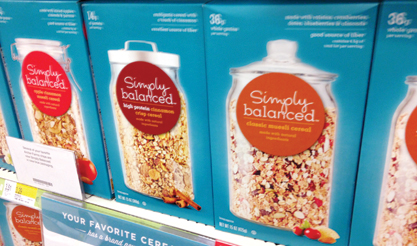
The Simply Balanced line of products — without artificial colors, flavors or preservatives — launched in June.
The evolution as it relates to the company’s grocery offering is perhaps most evident in the rollout of the new Simply Balanced line of Target private-label products, which debuted in June as a spinoff of the company’s higher-end Archer Farms label. It continues to offer products under both the Archer Farms label, which competes with national brands, and Market Pantry, which offers products at an entry-level price point.
Simply Balanced includes a range of about 250 items, many of which are organic, but all of which are positioned as more healthful alternatives. About three-fourths of the products in the line are currently GMO-free, and Target has also pledged to rid genetically modified ingredients from the line by the end of 2014.
It includes such items as teas, granolas and other products, all formulated without artificial flavors, coloring or preservatives. Several Simply Balanced products are also gluten-free, including gluten-free varieties of pastas, rice crackers and tortilla chips. Among the organic products in the line are milk, eggs, tea, pasta, pasta sauce, frozen fruits and vegetables, juice and soups.
The Target website offers recipes made specifically using products from the Simply Balanced line, and signs throughout the grocery department of stores promote the line by encouraging customers to “Take the guesswork out of eating well.”
 In rolling out the Simply Balanced line as a separate offering from Archer Farms, Target said it expects to expand its organic selection by about 25% over the next four years.
In rolling out the Simply Balanced line as a separate offering from Archer Farms, Target said it expects to expand its organic selection by about 25% over the next four years.
“The Simply Balanced line is helping that, but certainly you are seeing an overall expansion of the emphasis on organic and on more balanced offerings, more whole grain, and whole-food type things,” said Koo of Kantar.
She noted that the emphasis on natural offerings includes items in health and beauty care as well, where more natural product lines have been introduced, and in cleaning products as well.
“They are definitely approaching wellness as more of a lifestyle goal,” Koo explained, rather than just trying to appeal to customers who are simply seeking the best possible price on every item. “They are approaching it from a holistic perspective.”
Target also has been ramping up the in-store service component of its offering, which ties in with its overall focus on health and wellness. It recently began adding “beauty consultants” in about 200 stores, for example, to help customers
While not everyone might think of beauty advisors as aiding in the wellness effort, Target — with its emphasis on fashion as a factor that distinguishes it from rival Wal-Mart Stores — to some degree equates “looking good” with “feeling good.”
In addition to the new initiatives in grocery and beauty care, Target is testing a reinvigorated baby care department in 10 test stores, Koo said, which focuses on providing in-store service to new mothers.
Sign up here for SN’s free daily e-newsletter for Target and other retailer coverage
“With dedicated specialists, we’re seeing a lot more focus on trying to provide service in the stores than we have in the past,” Koo said.
The launch last year of Target’s exclusive “C9 by Champion” line of women’s athletic apparel helps extend the wellness message throughout the store, Koo noted.
“Now they are tying [wellness] in more with food and grocery, and they have their own fitness line as well,” said Koo. “So you do see this across the store, in terms of how do they help their guests live healthier lives.”
The emphasis on wellness serves to position the company as more of an authority on wellness, she said.
“They are saying, ‘How can we help our guests live their lives a little bit better?’ They are definitely doing a number of things that are coming from that authority, or advice-driven, position.”
Simplicity Challenge
Along those lines, Target also recently launched a “Simplicity Challenge” — an initiative leveraging crowd-sourced ideas about how to help guests simplify their lives.
The Simplicity Challenge seeks “innovative ideas to simplify health care,” Target said in promoting the effort, by asking customers to submit ideas in two categories — helping people make positive lifestyle choices to prevent illness, and helping people live better with chronic conditions.
Customers can submit ideas to a website Target created especially for the initiative — TargetSimplicityChallenge.com — and can also vote on their favorite ideas submitted by others.

Pharmacy has been a part of Target’s focus on wellness.
After the contest ends on Oct. 24, a panel will select the winning user-submitted entries, and the grand prize winners will receive $25,000 “and a chance to partner with Target to make their vision a reality,” the company promises.
“As a retailer serving millions of guests and an employer of more than 361,000 team members, Target recognizes the growing concern over health care in the U.S. and strives to be a positive part of the solution,” said José Barra, senior vice president of health and beauty, Target, in a statement announcing the challenge. “The Target Simplicity Challenge is designed to give visibility to those seemingly small, simple ideas that can have a big impact.”
In promoting the challenge and in its overall holistic approach to wellness, Koo noted that Target is “trying to emphasize that it is important to them, and they recognize that it is important to their guests.
“There’s a lot of anxiety, with all that’s going on with health care reform, and an aging Boomer population, and Target sees this as a way they can get involved in the conversation a little bit more.”
Digital Marketing
The Simplicity Challenge effort is also reflective of Target’s more interactive marketing approach, in which it is seeking to promote more customer engagement through various electronic vehicles, including its Facebook site and via mobile apps.
Target’s new mobile couponing program, dubbed Cartwheel, offers customers a range of coupons — including many for grocery items, but also for discounts on apparel, home goods and health and beauty care — they can select themselves and download to their mobile phones while they shop.
Discounts range from 5% to 20%, which are offered on top of the 5% REDcard rewards offered to shoppers who are members of that loyalty program.

In a recent earnings call, Gregg Steinhafel, chairman, president and chief executive officer, said Cartwheel “has seen very high levels of guest engagement.”
“In fact, our partners at Facebook have told us that engagement statistics for Cartwheel are among the best they have seen in the beta stage of any app, both within and outside the retail space,” he said.
Kathryn Tesija, executive vice president of merchandising, said Target has seen redemption rates “in excess of 50%” for offers downloaded by shoppers while they’re in the stores.
“We’re pleased with these initial results, and will apply what we’ve learned to improve both the Cartwheel experience as well as the development of our multichannel experiences in the future,” she said in a conference call discussing second-quarter results.
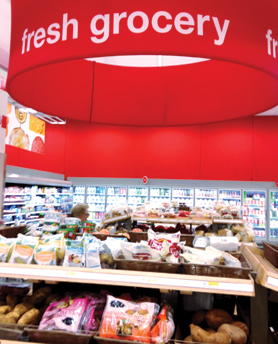
After rolling out P-fresh remodels that have greatly expanded its offering of food products in most of its stores
The rollout of Cartwheel precedes a site-to-store online ordering initiative that is being tested in Minneapolis and is expected to roll out in time for the holidays, and follows the company’s acquisition of several small e-commerce specialists, including the websites chefs.com and cooking.com.
Deborah Weinswig, an analyst at Citi Research, New York, cited omnichannel efforts as among Target’s strengths as it seeks to cope with the lingering economic malaise that has impacted its customers.
“Target saw the impact of the 2% payroll tax increase on sales almost immediately this year, and it lost discretionary trips as a result,” she wrote in a recent research report following a visit to the company’s headquarters. “Pressure has been most pronounced on the low-end customer.”
One-third of Target’s sales are to households earning less than $50,000, she noted.
“However, the economic environment is slowly getting better, and Target has several initiatives to drive traffic, including new tests in baby, electronics, and health and wellness, better localization, a greater focus on reaching out to Millennials and Hispanics, and growing omnichannel.”
Pricing
Although it doesn’t always get credit for it from consumers, Target has remained relatively competitive with Wal-Mart Stores on pricing, particularly in grocery items, according to research by Kantar.
The most recent price survey, released in July, showed that a comparable basket of edible groceries at the two chains was only 6 cents cheaper at Wal-Mart. Target closed the gap — which had been wider at the start of the year — through a series of temporary price cuts.
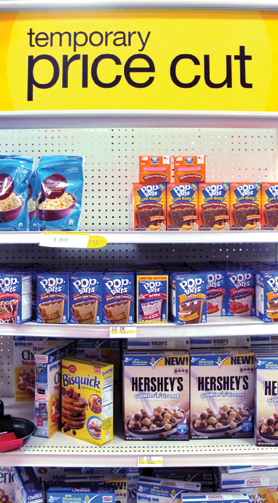
Target has remained competitive with Wal-Mart on price in part through temporary price reductions.
“The two retailers continue to strategically diverge in how they reach relative basket comparability, with Wal-Mart very much focused on building a strong value proposition through EDLP,” said Robin Sherk, director of retail insights at Kantar. “In contrast, Target selectively relies on temporary discounts to narrow the gap, and then offers guests ways to save even more through loyalty programs such as its REDcard.”
On health and beauty care items, the Kantar research found Target actually to be slightly cheaper than its rival.
Overall, the basket of edible grocery, nonfood grocery and health and beauty care items totaled $240.87 at Wal-Mart, vs. $246.72 at Target.
Koo of Kantar noted that Target has shifted its tactics toward driving more trips from all customers, rather than focusing on driving more sales from its more loyal shoppers.
“Target has been having trouble getting enough traffic — its transactions have been down,” she noted.
“They had been very focused in the last five years on trying to get more wallet share out of the people that are loyal to Target. Now they have really turned it around in the last couple of months. They have realized they can’t squeeze any more out of this lemon. They are at the end of their rope in terms of how much they can get from those folks.
“So, they have tried to expand their focus a little bit, to not just be focused on trying to get more shoppers in general. They are saying, ‘What about those shoppers who come in maybe once a month? How do we get those shoppers to come into the store more often?’”
To achieve that goal, the company has become “a little more assertive on the ‘Pay Less’ part” of its “Expect More, Pay Less” proposition, Koo explained.
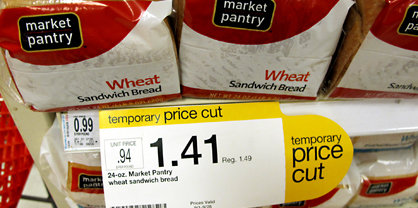
Its Market Pantry line offers entry-level price points on grocery product.
“They are definitely aware of the fact that their price perception has perhaps skewed in a way that is not beneficial to them, and are focused on getting folks to come in and feel that they are getting a good deal.”
While the expansion of grocery and fresh foods has helped drive basket size and frequency, the company is not getting the same relative boost it got from the initial P-fresh rollout, Koo noted.
“Their runway from what they are going to be getting out of P-fresh isn’t as high as it was in the past,” she said. “You do see this a little bit in the comps. While grocery and consumables are definitely stable and consistent, you are just not getting that juice where more people are coming into the stores, and more people are shopping more departments.”
Sign up for SN’s Fresh Takes e-newsletter for “News from the Supermarket Perimeter”
John Dean, a Minneapolis-based consultant who has followed Target, said he’s not sure what Target’s next big move will be now it has rolled out P-fresh and entered Canada.
“They have pretty much converted the conventional formats into P-fresh, other than the ones that are restricted by lease or they don’t have the opportunity or desire to do those at this point,” he said. “How they are going to promote and advertise it in the future is an unknown at this point.
“They basically have the message that you might not have the variety you might want, but if you are in the stores, you can find whatever you need for dinner, even if it’s not the meal you thought of initially.”
Wal-Mart Vs. Target

Sidebar: Canada Offers a Chilly Welcome
Target Corp.’s drive northward into Canada has hit a few bumps in the road.
The retailer, which has opened more half of the 124 stores it has planned for the country this year, said shoppers North of the Border have a misperception about the company’s pricing — particularly in consumables food and health care products.
“Multiple surveys indicate that our prices are very competitive and right where they need to be when compared to competition in local markets,” said Gregg Steinhafel, chairman, president and chief executive officer, Target, in a recent conference call with analysts. “Yet, we know there is a gap in guest awareness of how low our prices really are. As a result, we are deploying multiple tactics to help our guests better understand the great value and convenience we provide in these categories.”
Infographic: Target Seeks Share of Canada Market
The company had a conscious plan to lead with more aggressive promotions of home goods and apparel as it entered the market, he explained.
“Now we have to just turn on the gas a little bit on the other side of the equation to make sure that we’re getting the Canadian guests to understand what great values we offer on frequency categories and break some of those well-established habits,” Steinhafel said.
He noted that the company’s REDcard membership-discount program penetration is relatively weak in Canada, although the company expects that to grow over time.
John J. Mulligan, Target’s chief financial officer, said REDcard penetration was at about 2.3% in Canada in the second quarter.
He noted that Canadian segment sales accelerated from the first quarter to the second quarter, but the company saw “a slower-than-expected ramp-up in sales following the grand opening rush, particularly in our frequency categories.”
Deborah Weinswig, an analyst with New York-based Citi Research, said she noticed several out-of-stocks on grocery and other items on a recent visit to Canadian Target stores, confirming what had been widely reported by local media.
“We were underwhelmed by our shopping experience at the Target store in the Square One Mall in Mississauga, Ontario,” she noted, adding the 160,000-square-foot location was expected to be a high-volume performer.
“The biggest surprise was the significant out-of-stocks in consumables, beauty and home. In addition, traffic was softer-than-expected, especially when compared to the Walmart store in the same mall.”
Weinswig noted that the company had just launched consumables prominently in its circulars for the first time, and did not appear adequately stocked.
Suggested CategoriesMore from Supermarketnews
- Latest News
- Top 75 Retailers & Wholesalers
- Top 50 Small Chains & Independents
- Top 25 Global Retailers
- Power 50

